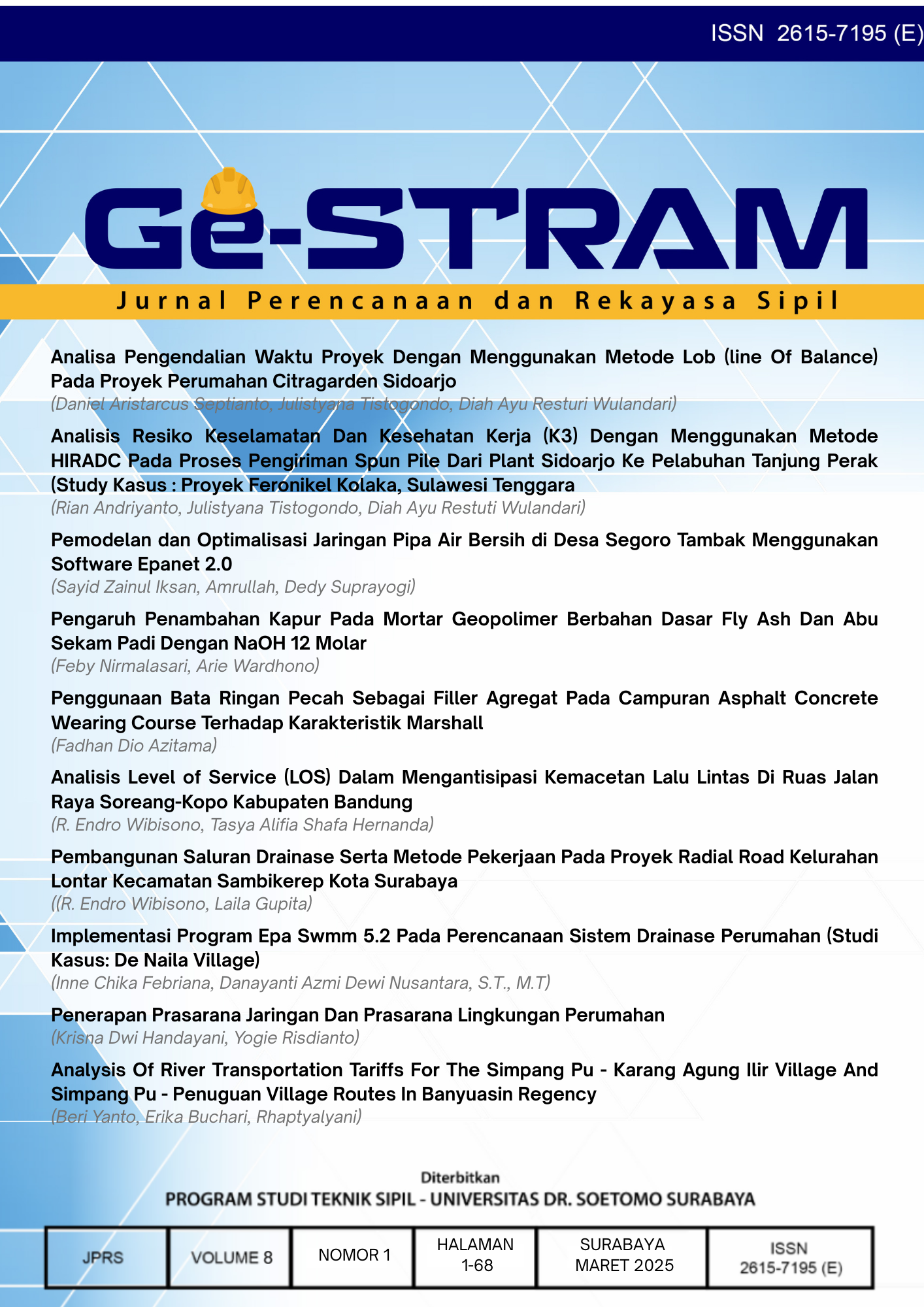Analisa Pengendalian Waktu Proyek Dengan Menggunakan Metode Lob (Line Of Balance) Pada Proyek Perumahan Citragarden Sidoarjo
 Abstract views: 100
,
Abstract views: 100
,
 PDF downloads: 56
PDF downloads: 56
Abstract
Every construction project inevitably involves project execution, including managing project completion timelines. Time management is crucial for any construction project, particularly when it comes to cost details that significantly impact project success. In specific projects, such as residential homes, shophouses, condominiums, and other repetitive projects, completion times are often inefficient. The Line of Balance (LoB) method is a technique used to determine the duration required to complete a construction project. The Line of Balance (LoB) method, also known as the balance line method, is highly effective for projects involving numerous repetitions, such as highways, housing developments, and similar buildings. This thesis utilizes the CitraGarden Sidoarjo accommodation project as a case study. The Existing Schedule method estimates a completion time of 53 weeks for a single house, whereas the project time for four houses totals 212 weeks, as illustrated by the S-curve project data. In contrast, for two pairs or four houses, the Line of Balance (LoB) method requires 113 weeks to complete the project. Thus, the Line of Balance (LoB) method accelerates the calculation of project completion time for the CitraGarden Sidoarjo housing project.
References
Arianti, I. (2015). Barchart Dan Penjadwalan Proyek. Slide Share. https://www.slideshare.net/angreliany/barchart-dan-penjadwalan-proyek
Aulia., Farisi, Wibowo, & Hidayat, A. (2016). Analisis Penggunaan Metode Penjadwalan Line Of Balance Pada Proyek Konstruksi Repetitif (Studi Kasus : Proyek Pembangunan Apartemen Candiland – Semarang), Jurnal Karya Teknik Sipil, Volume 6, Nomor 1, Tahun 2017, Halaman 211 – 219.
Erizal, (2018). Perencanaan, Penjadwalan Dan Pengendalian Proyek Konstruksi. Modul Presentasi. http://web.ipb.ac.id
Garcinia, G., & Nugraheni, F. (2019). Analisis Penjadwalan Ulang Proyek Dengan Metode PERT (Program Evaluation And Review Technique) (Studi Kasus Pembangunan RSUD Tipe B Magelang). Jurnal ilmiah. Hal 3, Teknik Sipil Universitas Islam Indonesia.
Hafnidar A. Rani. (2016). Manajemen Proyek Konstruksi -Ed. 1, Cet. 1 - Deepublish.
Handayani, M. T. (2021). Manajemen Konstruksi: Pengertian, Tujuan, Fungsi, Peran, serta Tugasnya. Web Artikel. https://www.maxmanroe.com/vid/manajemen/pengertian-manajemenkonstruksi.html
Haryanto, B. B. (2016). Kurva S Dalam Dunia Konstruksi Dan Pengertiannya Dari Beberapa Sumber. Web Artikel. http://boghengmusic.blogspot.com/2016/11/kurva-s-dalam-duniakonstruksi.html
Husin, A. E. dan B. D. (2018). The Integration Of Application Line Of Balance And Six Sigma Methods In Finishing Works At Hotel High Rise Building. International Journal Of Scientific Research Engineering & Technology (IJSRET). Jurnal ilmiah. Universitas Indonesia. 7.
M. Prawiro. (2020). Manajemen Konstruksi: Pengertian, Tujuan, Fungsi, Peran, serta Tugasnya. https://www.maxmanroe.com/vid/manajemen/pengertian-manajemenkonstruksi.html
Putri, H. (2020). Mengetahui Perbedaan, Persamaan Antara PERT dan CPM. Web Artikel. http://www.jejakhimea.com/2020/11/mengetahui-perbedaanpersamaan-antara.html
Rabbani, A. (2021). Pengertian Network Planning, Manfaat, Metode, Simbol, Aturan dan Penyusunan. Web Artikel. https://www.sosial79.com/2021/07/pengertian-network-planningmanfaat.html
Riadi, M. (2019). Pengertian, Manfaat, Metode dan Penyusunan Network Planning. Diambil Dari Https://Www.Kajianpustaka.Com/2019/02/Pengertian-Manfaat-Metode-Dan-Penyusunan-Network-Planning.Html. Tanggal 31 Maret 2021. https://www.kajianpustaka.com/2019/02/pengertian-manfaat-metode-dan-penyusunan-network-planning.html
Safitri Jaya. (2017). Manajemen Proyek Teknologi Informasi. Modul Ajar. Universitas Pembangunan Jaya.
Situmorang, P. D. (2017). Analisa Penjadwalan Proyek dengan Time Schedule Kurva S, Precedence Diagram Method (PDM) dan Ranked Positional Weight Method (RPWM). Jurnal Teknik Sipil Universitas Sumatera Utara, 3(7), 93–112
Copyright (c) 2025 Julistyana Tistogondo

This work is licensed under a Creative Commons Attribution-ShareAlike 4.0 International License.
Authors who publish with this journal agree to the following terms:
- Authors retain copyright and grant the journal right of first publication with the work simultaneously licensed under a Creative Commons Attribution-ShareAlike 4.0 International License that allows others to share the work with an acknowledgement of the work's authorship and initial publication in this journal.
- Authors are able to enter into separate, additional contractual arrangements for the non-exclusive distribution of the journal's published version of the work (e.g., post it to an institutional repository or publish it in a book), with an acknowledgement of its initial publication in this journal.
- Authors are permitted and encouraged to post their work online (e.g., in institutional repositories or on their website) prior to and during the submission process, as it can lead to productive exchanges, as well as earlier and greater citation of published work (See The Effect of Open Access).

This work is licensed under a Creative Commons Attribution-ShareAlike 4.0 International License.















